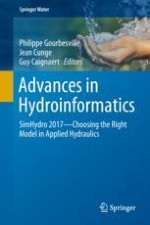2018 | OriginalPaper | Buchkapitel
Evaluating 3D Hydraulic Conditions to Favour Sediment Transport and Erosion Through a Reservoir: Hybrid Modelling of Champagneux Run-of-River Dam on the Rhône River, France
verfasst von : Damien Alliau, Magali Decachard, Carole Wirz, Christophe Peteuil, Sylvain Reynaud, Antoine Vollant
Erschienen in: Advances in Hydroinformatics
Verlag: Springer Singapore
Aktivieren Sie unsere intelligente Suche, um passende Fachinhalte oder Patente zu finden.
Wählen Sie Textabschnitte aus um mit Künstlicher Intelligenz passenden Patente zu finden. powered by
Markieren Sie Textabschnitte, um KI-gestützt weitere passende Inhalte zu finden. powered by
